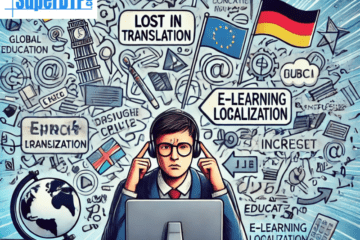What is E-Learning Localization?
E-learning localization means to adapt content to particular regions and audiences. This starts with language, but can also go further and include the exchange of images.
How we achieve effective e-Learning localization for our clients:
- Focus on both design and words.
- Recognize the nuances of the target market.
- Voice localization.
- Creating modules that are easier to localize.
- Creating a localization toolkit for your company.
Here are some key technical considerations for e-learning localization:
- Language Support: Ensure that the e-learning platform and content management system (CMS) support the languages needed for localization. This includes not only the interface but also the ability to display and handle different character sets and writing systems.
- Content Management System (CMS): Choose a CMS that allows for easy localization, including the ability to manage multiple versions of content, handle different languages, and support translation workflows.
- Multimedia Compatibility: Ensure that multimedia elements such as audio, video, and interactive content are compatible with localization requirements. This includes providing subtitles, captions, or alternative audio tracks for different languages.
- Text Expansion and Contraction: Be aware of how text length may vary between languages. Ensure that the design of your e-learning content allows for text expansion or contraction without breaking the layout or design.
- Cultural Adaptation: Consider cultural differences when localizing content. This includes not only language but also visuals, examples, and case studies that may need to be adapted to be relevant and relatable to the target audience.
- User Interface (UI) Design: Ensure that the user interface elements, such as buttons, menus, and navigation, are designed to accommodate different languages and writing systems. Consider the direction of text (left-to-right vs. right-to-left) and other cultural preferences.
- Localization Tools: Use localization tools and technologies to streamline the localization process. This includes translation management systems (TMS), glossaries, and translation memory tools to ensure consistency and efficiency.
- Quality Assurance (QA): Implement a rigorous QA process to ensure that the localized content is accurate, culturally appropriate, and functions correctly in the target language and region.
- Scalability and Maintenance: Plan for scalability and ongoing maintenance of localized content. This includes updating content, managing versions, and ensuring that the localization remains effective over time.
- Accessibility: Ensure that the localized content is accessible to all learners, including those with disabilities.
Benefits of E-Learning Localization
- Localization helps improve the learnability quotient, which in turn increases learner productivity and employer ROI.
- It helps improve learning curves and learner engagement through culturally relevant presentations to any audience.
- It reduces the need for pre-processing and facilitates multilingual LMS integration.
- The content curation process helps identify culturally sensitive content and flags potentially conflictive images, colors, idioms, etc. This is key for any company aiming to attain high achievement levels.
- It helps companies adapt their content to different platforms such as mobile and web-based courses that may pose different processing challenges and demand more or less complex workflows.
Why Choose SuperDTP?
Superdtp is a leading provider of multilingual desktop publishing (DTP) services, offering high-quality solutions for a wide range of industries.
Here are some reasons why you might consider choosing Superdtp:
Expertise: Superdtp has a team of experienced professionals who are experts in desktop publishing and localization. They have the knowledge and skills to handle complex projects and ensure that your materials are effectively localized for your target audience.
Quality: Superdtp is committed to delivering top-quality results. They use advanced tools and techniques to ensure that your documents are accurate, visually appealing, and culturally appropriate.
Flexibility: Superdtp understands that every project is unique. They offer a flexible approach, allowing you to customize their services to meet your specific needs and requirements.
Customer Service: Superdtp prides itself on providing excellent customer service. They are responsive, attentive, and dedicated to ensuring that you are satisfied with the final product.
Competitive Pricing: Superdtp offers competitive pricing for their services, making them a cost-effective choice for your desktop publishing and localization needs.
Conclusion
In conclusion, localizing e-learning content is essential for reaching a global audience and maximizing your impact. By adapting your content to suit local cultural norms and educational practices, you can improve learning outcomes and build stronger relationships with your audience. Additionally, by using appropriate tools and strategies, you can ensure that your content is accessible to people with different abilities. By following the tips and strategies outlined in this article, you can successfully localize your e-learning content and make a positive impact on society.
Super DTP Ltd is a specialized desktop publishing agency in Gabrovo Bulgaria, offering book publishing, Multilingual DTP Services, and E-learning Localization Services to translation agencies and localization companies worldwide! Check our services at www.superdtp.com or contact us at dtp.bulgaria@gmail.com for further details.


